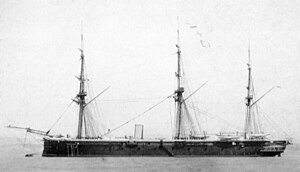
The seventh HMS Enterprise of the Royal Navy was an armoured sloop launched in 1864 at Deptford Dockyard. Originally laid down as a wooden screw sloop of the Camelion class, she was redesigned by Edward Reed and completed as a central battery ironclad. The ship spent the bulk of her career assigned to the Mediterranean Fleet before returning to England in 1871 where she was paid off. Enterprise was sold for scrap in 1885.
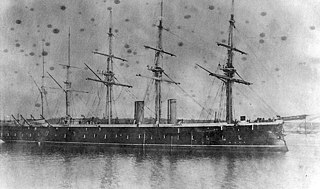
HMS Agincourt was a Minotaur-class armoured frigate built for the Royal Navy during the 1860s. She spent most of her career as the flagship of the Channel Squadron's second-in-command. During the Russo-Turkish War of 1877–1878, she was one of the ironclads sent to Constantinople to forestall a Russian occupation of the Ottoman capital. Agincourt participated in Queen Victoria's Golden Jubilee Fleet Review in 1887. The ship was placed in reserve two years later and served as a training ship from 1893 to 1909. That year she was converted into a coal hulk and renamed as C.109. Agincourt served at Sheerness until sold for scrap in 1960.

The Warrior-class ironclads were a class of two warships built for the Royal Navy between 1859 and 1862, the first ocean-going ironclads with iron hulls ever constructed. The ships were designed as armoured frigates in response to an invasion scare sparked by the launch of the French ironclad Gloire and her three sisters in 1858. They were initially armed with a mix of rifled breech-loading and muzzle-loading smoothbore guns, but the Armstrong breech-loading guns proved unreliable and were ultimately withdrawn from service.

HMS Black Prince was the third ship of that name to serve with the Royal Navy. She was the world's second ocean-going, iron-hulled, armoured warship, following her sister ship, HMS Warrior. For a brief period the two Warrior-class ironclads were the most powerful warships in the world, being virtually impregnable to the naval guns of the time. Rapid advances in naval technology left Black Prince and her sister obsolete within a short time, however, and she spent more time in reserve and training roles than in first-line service.
HMS Valiant was the second ship of the Hector-class armoured frigates ordered by the Royal Navy in 1861. Her builders went bankrupt shortly after she was laid down, which significantly delayed her completion. After being launched in 1863, she waited a further five years to receive her guns due to supply issues. Upon being commissioned in 1868 the ship was assigned as the First Reserve guard ship for Southern Ireland, where she remained until she was decommissioned in 1885. Valiant was hulked in 1897 as part of the stoker training school HMS Indus before becoming a storeship for kite balloons during the First World War. The ship was converted to a floating oil tank in 1926 and served in that role until sold for scrap in 1956.

HMS Minotaur was the lead ship of the Minotaur-class armoured frigates built for the Royal Navy during the 1860s. Minotaur took nearly four years between her launching and commissioning because she was used for evaluations of her armament and different sailing rigs.

HMS Iron Duke was the last of four Audacious-class central battery ironclads built for the Royal Navy in the late 1860s. Completed in 1871, the ship was briefly assigned to the Reserve Fleet as a guardship in Ireland, before she was sent out to the China Station as its flagship. Iron Duke returned four years later and resumed her duties as a guardship. She accidentally rammed and sank her sister ship, Vanguard, in a heavy fog in mid-1875 and returned to the Far East in 1878. The ship ran aground twice during this deployment and returned home in 1883. After a lengthy refit, Iron Duke was assigned to the Channel Fleet in 1885 and remained there until she again became a guardship in 1890. The ship was converted into a coal hulk a decade later and continued in that role until 1906 when she was sold for scrap and broken up.

HMS Royal Oak was a Prince Consort-class armoured frigate built for the Royal Navy in the 1860s. The lead ship of her class, she is sometimes described as a half-sister to the other three ships because of her different engine and boiler arrangements. Like her sisters, she was converted into an ironclad from a wooden ship of the line that was still under construction.
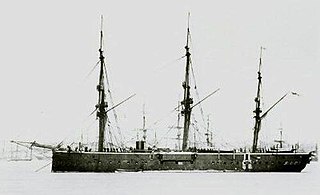
HMS Audacious was the lead ship of the Audacious-class ironclads built for the Royal Navy in the late 1860s. They were designed as second-class ironclads suitable for use on foreign stations and the ship spent the bulk of her career on the China Station. She was decommissioned in 1894 and hulked in 1902 for use as a training ship. The ship was towed to Scapa Flow after the beginning of the First World War to be used as a receiving ship and then to Rosyth after the war ended. Audacious was sold for scrap in 1929.
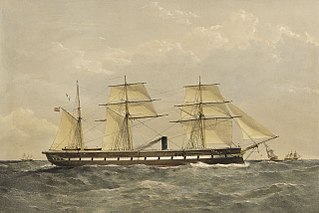
HMS Resistance was the second of two Defence-class ironclads built for the Royal Navy in the 1860s. She was the first capital ship in the Royal Navy to be fitted with a ram and was given the nickname of Old Rammo. Resistance was initially assigned to the Channel Fleet upon commissioning, but was transferred to the Mediterranean Fleet in 1864, the first ironclad to be assigned to that fleet. She was rearmed in 1867 and became a guardship when recommissioned in 1869. The ship was reassigned to the Channel Fleet in 1873 before reverting to her former duties in 1877. Resistance was decommissioned in 1880 and was used for gunnery and torpedo trials beginning in 1885. The ship was sold for scrap in 1898 and foundered in 1899 en route to the breaker's yard. She was salvaged and later scrapped.

The Defence-class ironclads were a class of two warships built for the Royal Navy between 1859 and 1862. The ships were designed as armoured frigates in response to an invasion scare sparked by the launch of the French ironclad Gloire and her three sisters in 1858. They were initially armed with a mix of rifled breech-loading and muzzle-loading smoothbore guns, but the Armstrong breech-loading guns proved unreliable and were withdrawn from service after a few years.
The Hector-class ironclads were a pair of armoured frigates built for the Royal Navy (RN) in the 1860s. Hector was completed in 1864 and assigned to the Channel Fleet until she began a refit in 1867. Valiant's builder went bankrupt and delayed her launching by a year. The ship then had to wait almost another five years to receive her guns and be commissioned. Both ships were assigned to the Reserve Fleet from 1868 until they were paid off in 1885–1886. They were mobilized during the Russo-Turkish War of 1877–1878, but saw no action. They were hulked in the late 1890s and assigned to shore establishments. Hector was scrapped in 1905, but Valiant was converted into a floating oil tank in 1926; she was sold for scrap thirty years later.
HMS Hector was the lead ship of the Hector-class armoured frigates ordered by the Royal Navy in 1861. Upon completion in 1864, she was assigned to the Channel Fleet. The ship was paid off in 1867 to refit and be re-armed. Upon recommissioning in 1868, she was assigned as the guard ship of the Fleet Reserve in the southern district until 1886. She usually served as Queen Victoria's guard ship when the sovereign was resident at her vacation home on the Isle of Wight. Hector was paid off in 1886 and hulked in 1900 as a storage ship before being sold for scrap in 1905.

HMS Achilles was an armoured frigate built for the Royal Navy in the 1860s. Upon her completion in 1864 she was assigned to the Channel Fleet. The ship was paid off in 1868 to refit and be re-armed. When she recommissioned in 1869, she was assigned as the guard ship of the Fleet Reserve in the Portland District until 1874. Achilles was refitted and re-armed again in 1874 and became the guard ship of the Liverpool District in 1875. Two years later, she was rejoined the Channel Fleet before going to the Mediterranean in 1878. The ship returned to the Channel Fleet in 1880 and served until she was paid off in 1885.

HMS Lord Clyde was the name ship of the wooden-hulled Lord Clyde class of two armoured frigates built for the Royal Navy (RN) during the 1860s. She and her sister ship, Lord Warden, were the heaviest wooden ships ever built and were also the fastest steaming wooden ships in the RN. Lord Clyde was initially assigned to the Channel Fleet in 1866, but was transferred to the Mediterranean Fleet in 1868. The ship suffered engine problems throughout her career and it needed to be replaced after only two years of service. She rejoined the Mediterranean Fleet in 1871, but was badly damaged when she ran aground the next year. When Lord Clyde was under repair, her hull was found to be rotten and she was sold for scrap in 1875.

HMS Lord Warden was the second and last ship of the wooden-hulled Lord Clyde class of armoured frigates built for the Royal Navy (RN) during the 1860s. She and her sister ship, Lord Clyde, were the heaviest wooden ships ever built and were also the fastest steaming wooden ships. They were also the slowest-sailing ironclads in the RN.
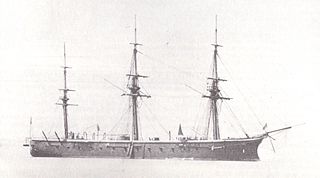
HMS Bellerophon was a central battery ironclad built for the Royal Navy in the mid-1860s.

HMS Neptune was an ironclad turret ship originally designed and built in Britain for Brazil, but acquired for the Royal Navy in 1878. Modifications to suit the Royal Navy took three years to complete and the ship did not begin her first commission until 1883 with the Channel Fleet. She was transferred to the Mediterranean Fleet in 1885, but refitted in Portsmouth in 1886–87. Neptune then became the coastguard ship for the 1st Class Reserve at Holyhead until 1893 when she was placed in reserve in Portsmouth. While she was being towed to the breakers in 1903, Neptune unintentionally rammed HMS Victory, then serving as a training hulk for the Naval Signal School, collided with HMS Hero, and narrowly missed several other ships. She was scrapped in Germany in 1904.

The Cyclops-class monitor was a group of four ironclad breastwork monitors built for the Royal Navy during the 1870s. They were slightly modified versions of the Cerberus-class monitors. The ships were ordered to satisfy demands for local defence during the war scare of 1870, but the pace of construction slowed tremendously as the perceived threat of war declined. The Cyclops-class monitors spent most of their careers in reserve and were finally sold off in 1903.

HMS Hydra was the second ship completed of the four Cyclops-class breastwork monitors built for the Royal Navy during the 1870s. The ships were ordered to satisfy demands for local defence during the war scare of 1870, but the pace of construction slowed tremendously as the perceived threat of war declined. The ship spent most of her career in reserve; her only sustained period in commission was four months during the Russo-Turkish War in 1878 when the British were trying to force the Russians to end the war without seizing Constantinople. Hydra was sold for scrap in 1903.
